How do Solar-Powered Portable Power Stations Work? - A Comprehensive Guide
If you are new to the world of portable power, you may not be aware of your options when it comes to eco-friendly and silent power generation. If a quiet, eco-friendly power solution is on your radar, read on to learn more about how solar powered portable power stations work and how they can be the solution to your away-from-home power needs.
Understanding Solar-Powered Portable Power Stations
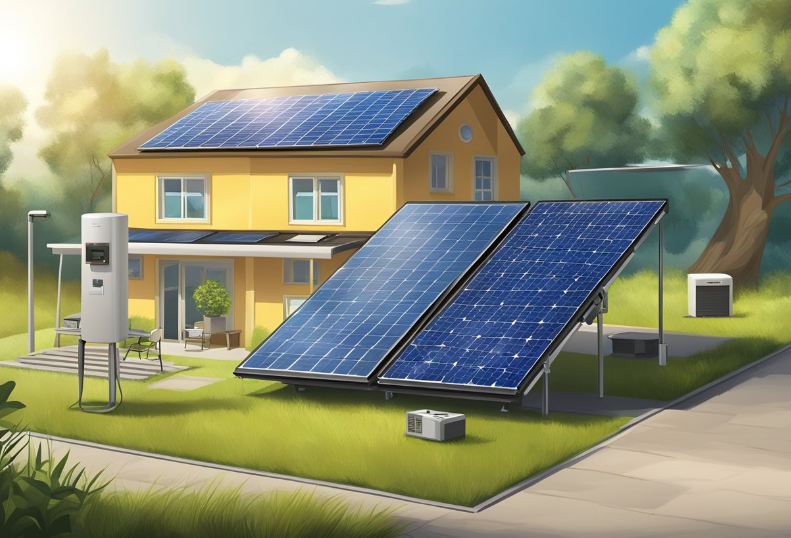
How They Work
Solar-powered portable power stations work by capturing sunlight through solar panels and converting it into electricity that can be stored in a battery. This stored electricity can then be used to power your devices and appliances when off-grid or during emergencies. The process is clean and renewable, as it harnesses solar energy without emitting any pollutants.
When you connect your devices to the power station, an inverter converts the stored DC electricity into AC electricity, which is compatible with most devices. The inverter is responsible for regulating the output of electricity to ensure that the correct voltage and frequency is maintained for your devices.
Key Components
- Solar panels: These are used to capture sunlight and convert it into electricity. Solar panels can vary in size and power output depending on the portable power station's capacity and intended use. They can be integrated into the power station or connected externally.
- Battery: The battery is the heart of a portable power station, as it stores the electricity generated by the solar panels. Batteries can vary in capacity, with larger batteries able to store more watt-hours of energy. Most portable power stations use lithium-ion batteries due to their high energy density and low weight.
- Inverter: This component converts the DC electricity stored in the battery into AC electricity, which is used by many devices and appliances. The inverter also regulates the electricity output to prevent damage to your devices.
- Solar charge controller: This vital component protects the battery from overcharging and ensures that the solar panels are operating efficiently. Some portable power stations use an MPPT (Maximum Power Point Tracking) solar charge controller, which optimizes the solar input and can significantly improve the efficiency of the system.
Remember to choose a solar-powered portable power station that is suitable for your needs in terms of power output, battery capacity, and solar input. These stations can be a reliable choice for off-grid adventure, emergency preparedness, or simply to reduce your reliance on traditional energy sources.
Features of Solar-Powered Portable Power Stations

Battery Life
One of the crucial aspects of a solar-powered portable power station is its battery life. The battery life determines how long the power station can supply electricity to your devices during an outage or outdoor adventure. These stations typically have built-in, high-capacity batteries measured in watt-hours. The battery capacity determines how much power can be stored and used when there is no sunlight or during nighttime.
Output Power
Solar-powered portable power stations provide various output power options to cater to a wide range of needs. Whether you need to charge small devices like phones and tablets, power essential household appliances during emergencies, or use power tools outdoors, these stations come equipped with multiple options. Common output options include USB ports, USB-C outlets for fast charging, and AC outlets providing standard household power levels. Some models, like the EcoFlow Delta, even supply higher power output for large appliances and equipment.
Portability
A significant advantage of solar-powered portable power stations is their portability. They are designed to be compact, lightweight, and easy to transport. This makes them ideal for use during outdoor activities, camping trips, or emergencies when you need a reliable backup power source. Many power stations, like the Goal Zero Yeti series, offer sturdy designs and handles for easy carrying.
Ease of Use
Solar-powered portable power stations are known for their user-friendly interfaces. They often have clear and informative displays that show essential information, such as the remaining battery life, power output, and charging times.
Additionally, they integrate seamlessly with solar panels, allowing you to harness clean energy from sunlight efficiently. The maintenance needs for these power stations are minimal, making them a worry-free solution for sustainable power during outages or outdoor adventures.
By understanding these key features, you can select a solar-powered portable power station that best suits your power needs without compromising on portability or ease of use.
Comparisons and Alternatives

Conventional Generators
Compared to solar-powered portable power stations, conventional generators use fuel like gasoline, diesel, or propane to generate electricity. These generators can produce a continuous supply of power as long as they have access to fuel. However, they tend to be noisy, require regular maintenance, emit harmful emissions, and might not be suitable for indoor use. On the other hand, solar-powered portable power stations are environmentally friendly, quiet, and require little to no maintenance.
Portable Power Banks
Portable power banks are compact rechargeable battery packs that can charge small devices like smartphones, tablets, and cameras using USB ports. In contrast, solar-powered portable power stations are larger and have higher watt-hour capacities, typically ranging from 200Wh to 2000Wh+.
They are designed to power multiple devices simultaneously, including larger appliances, such as laptops and mini fridges, through AC outlets. You can also connect solar panels to your portable power station, turning it into a solar generator, and harness solar energy to recharge the battery.
While choosing between a solar-powered portable power station and alternative options like conventional generators and portable power banks, you should consider your specific power needs and prioritize factors like portability, environmental impact, and noise levels. A solar-powered portable power station is an excellent choice for outdoor adventures, home backup during power outages, and anywhere you need access to clean, versatile power without the drawbacks of conventional generators.
Use Cases and Applications
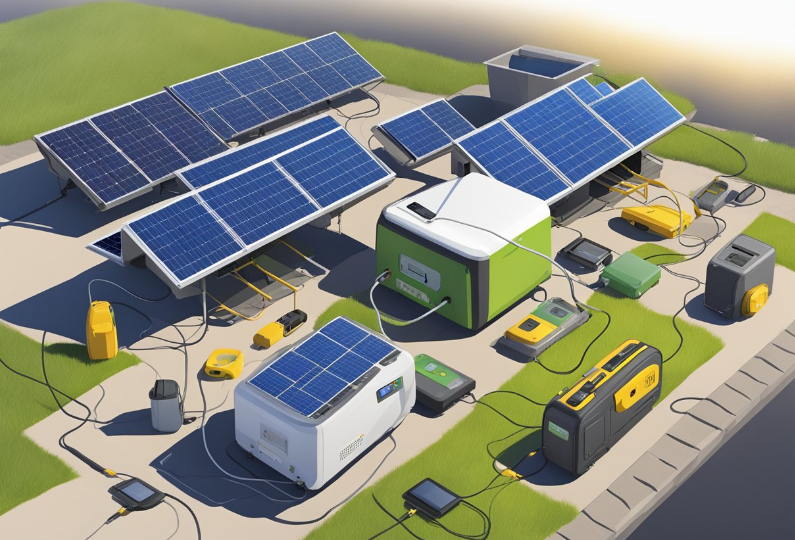
Camping and Hiking
When you're out camping or hiking, having a reliable power source is essential for charging your devices such as phones, cameras, and GPS. Solar-powered portable power stations, like Goal Zero and EcoFlow, provide an eco-friendly option for keeping your devices charged. These power stations can also power small appliances like camping lights or even a microwave for a short period, making your outdoor experience more comfortable and convenient.
Home Backup Power
Solar-powered portable power stations can serve as a backup power source for your home appliances during power outages. You can use them to power essential home equipment such as power tools, laptops, and small home appliances like microwaves or refrigerators for a limited time. Portable power stations like the EcoFlow River 2 and Jackery provide varying capacities, allowing you to choose a device based on your specific power needs.
Emergency Power Outages
In times of emergency power outages, solar-powered portable power stations offer a reliable and environmentally friendly power solution. By connecting your power station to solar panels, you can harness the sun's energy to charge the device during the day and provide power for your devices when the electricity grid fails. This setup allows you to stay connected and comfortable during emergencies without relying on traditional gas-powered generators, which can be noisy and produce harmful emissions.
Solar-Powered Portable Power Stations Brands and Options
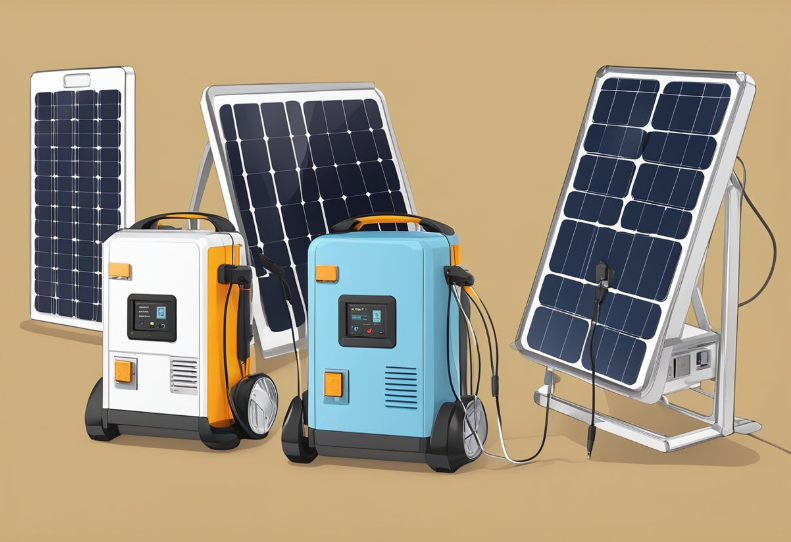
Goal Zero
Goal Zero offers a range of solar-powered portable power stations to cater to your needs. Their Yeti 200X Solar Generator is a popular choice due to its compact size, making it highly portable. With a user-friendly interface and easy maintenance, Goal Zero provides efficient energy storage solutions for the outdoors or emergencies.
EcoFlow
EcoFlow is another brand offering high-quality portable power stations. Their River 2 model is well-known for having a compact design, making it easy to transport. You can use EcoFlow power banks for both indoor and outdoor usage, ensuring reliable power access when you need it. EcoFlow's products provide an optimal balance of portability and storage capacity for your needs.
Delta
Delta, a brand under EcoFlow, produces the Delta Max, a powerful and versatile solar-powered portable power station. With its large storage capacity and user-friendly interface, the Delta Max can cater to various energy needs while being easily transportable. Designed for both indoor and outdoor use, you can trust Delta for high-performance energy storage and portability.
Jackery
Jackery is a renown brand in the portable power station market, offering innovative and reliable solutions for on the go power needs. With a commitment to sustainable energy, Jackery specializes in creating portable solar-powered power stations that cater to outdoor enthusiasts, campers, and emergency preparedness.
Anker
Anker has established itself as a leading brand in the technology and power solutions industry, and their foray into portable solar-powered power stations exemplifies their commitment to innovation. Anker's power stations are designed with a focus on efficiency, durability and modern aesthetics catering to outdoor enthusiasts and digital nomads.
Bluetti
Bluetti is a pioneering company at the forefront of renewable energy solutions, particularly known for its innovative line of solar-powered power stations. As a trailblazer in the clean energy industry, Bluetti focuses on developing reliable and sustainable power solutions for both indoor and outdoor use. Their solar power stations integrate cutting-edge technology with sleek design, providing users with a portable and eco-friendly alternative to traditional power sources.
Considerations When Buying Solar-Powered Portable Power Stations
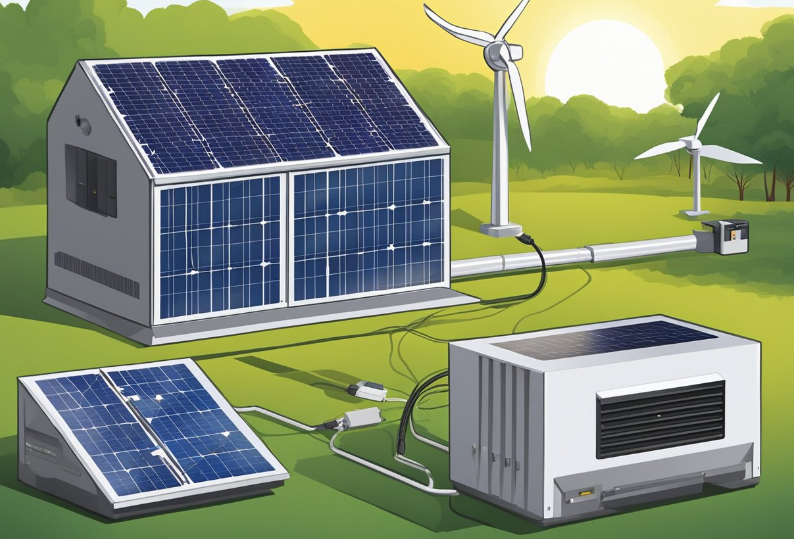
Before you invest in a solar-powered portable power station, there are several factors to consider. This guide will discuss the aspects of cost, efficiency, safety, and maintenance to help you make an informed decision.
Cost
When buying a solar-powered portable power station, it's crucial to consider the cost involved. Prices can range from a few hundred dollars to a few thousand, depending on the storage capacity, power output, and features.
Remember to compare the price with your power needs to determine if the investment is worth it. These units can be cost-effective in the long run by reducing emissions and reliance on non-renewable energy sources.
Efficiency
Efficiency is an essential factor when selecting a solar-powered portable power station. It is crucial to know how much energy the unit can store in watt-hours (Wh). For example, if a power station has a 100Wh capacity, it can provide 100 watts for one hour, or 10 watts for 10 hours.
Consider your power needs, such as charging phones, refrigerators, or running microwaves, and select a station with a suitable battery storage capacity. Moreover, check how efficiently the unit can convert solar energy into usable power, as high conversion rates can optimize your investment.
Safety
Safety should always be a primary concern when dealing with power stations. Examine the unit's safety features to ensure it protects against overcharges, overheating, and short circuits. Analyze the quality of the battery storage and its cycle life, as well as other components like AC outlets and tools. Remember to keep solar panels and power stations away from water or flammable materials.
Maintenance
Maintenance is another crucial aspect to think about when purchasing a solar-powered portable power station. Since they are battery-powered, they typically require less upkeep compared to traditional generators. However, it's essential to look for a model with easy-to-maintain components, such as removable batteries, reliable AC outlets, and readily available replacement parts.
The portability of the unit is also a key consideration, particularly for usage in emergency situations, RVs, or camping trips.
Understanding the factors of cost, efficiency, safety, and maintenance will guide you in selecting the right solar-powered portable power station for your needs. Take your time to compare different models and features to find the best option for your power requirements and lifestyle.
Environmental Impact and Sustainability
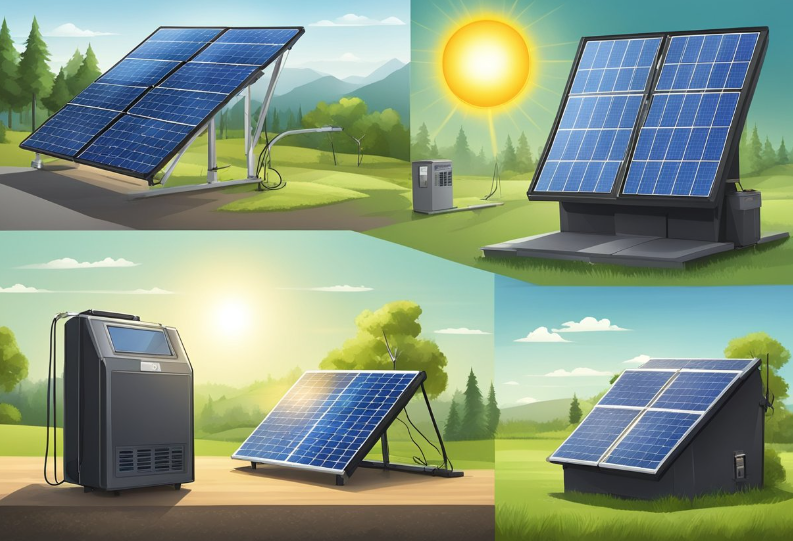
Compared to Fossil Fuels
When you use solar-powered portable power stations, you take a big step towards reducing your carbon footprint compared to traditional gas generators. Solar panels harness energy from the sun and convert it into electricity without burning fossil fuels, which means you eliminate the emissions produced by traditional power sources. Additionally, fuel consumption is drastically reduced as solar energy becomes your primary power source.
Since solar panels have a long lifespan, typically 25-30 years, they make for a durable and sustainable power solution. Moreover, by using a solar charge controller, you can extend the life of your portable power stations by regulating the flow of power to prevent overcharging and damage to your battery.
Renewable Energy
Solar energy is a clean, renewable source that offers many benefits for both the environment and our daily lives. By switching to solar-powered portable power stations, you contribute to a more sustainable future with reduced emissions, better air quality, and less energy dependency on non-renewable sources like fossil fuels.
One of the most significant advantages of solar energy is its virtually unlimited potential. The sun provides an abundant source of renewable energy that can be harnessed to power a wide range of devices, from refrigerators to small electronics. Through the use of solar panels and efficient solar charge controllers, you can effectively manage your energy consumption and contribute positively to the environment.
Overall, by choosing to invest in solar-powered portable power stations, you adopt a more environmentally friendly approach to energy consumption. It's a simple and effective way to reduce your carbon footprint, promote clean energy, and contribute towards a more sustainable future.
Frequently Asked Questions
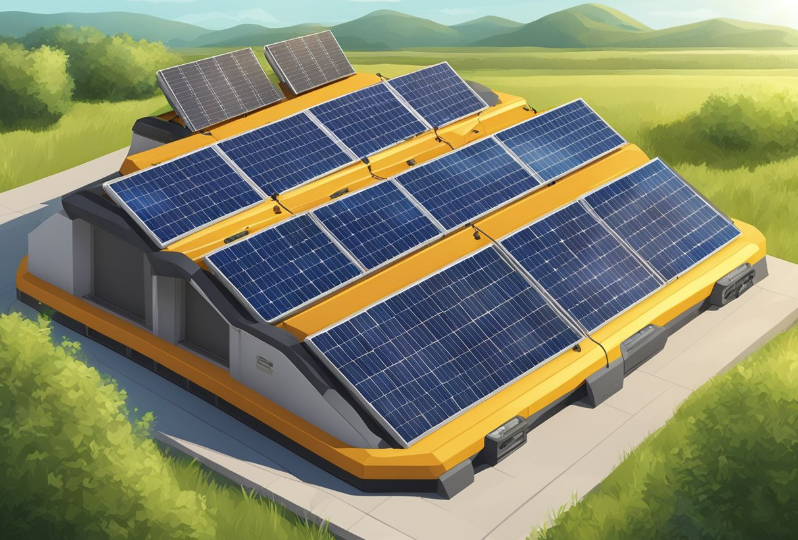
What are the key components of a solar-powered portable power station?
A solar-powered portable power station consists of a solar panel, rechargeable battery, inverter, and a charge controller. The solar panel captures sunlight and converts it into electricity. This electricity is then stored in the rechargeable battery, which is managed by the charge controller. The inverter helps convert the stored DC power into AC power, making it suitable to run your devices and appliances.
How long does it take to charge a solar-powered portable power station?
The time it takes to charge a solar-powered portable power station depends on factors like the size of the solar panels, battery capacity, and available sunlight. On average, it can take anywhere from a few hours to a full day to charge a portable power station. Keep in mind that the charging time may be impacted by weather conditions or the angle of the solar panels.
What factors impact the efficiency of a solar-powered portable power station?
The efficiency of a solar-powered portable power station is influenced by factors like the quality and efficiency of the solar panels, battery capacity, and charge controller efficiency. Additionally, weather conditions, like cloud cover or temperature, can also affect the performance of your power station. To maximize efficiency, ensure your solar panels are placed at the right angle and are kept clean.
Are solar-powered portable power stations suitable for home use?
Yes, solar-powered portable power stations can be used for home use. They are ideal for providing backup power during power outages or as a supplementary power source for off-grid living. However, their capacity may not be enough to power all your home appliances simultaneously. It's essential to consider your power needs and choose a power station with suitable battery capacity and inverter support.
What are the advantages of using solar-powered portable power stations?
Solar-powered portable power stations offer several advantages, they:
- are eco-friendly, using solar energy to generate electricity, thus reducing carbon emissions.
- help you save on electricity bills by providing an alternative power source.
- are portable and can be used during outdoor activities like camping or working in remote locations.
- provide a reliable backup power source during natural disasters or power outages.
What should be considered when choosing a solar-powered portable power station?
When choosing a solar-powered portable power station, consider the following factors:
- Battery capacity: Choose a power station with sufficient battery capacity to meet your power needs.
- Inverter rating: Ensure the power station has a compatible inverter to support the devices you plan on using.
- Solar panel efficiency: Look for a solar panel that has high efficiency to maximize energy production.
- Charge controller: Opt for a power station with an efficient charge controller to protect your battery and optimize charging.
- Portability: If you plan on using the power station on the go, consider its weight and dimensions.
- Cost: Select a power station that fits your budget without compromising on quality and features.
